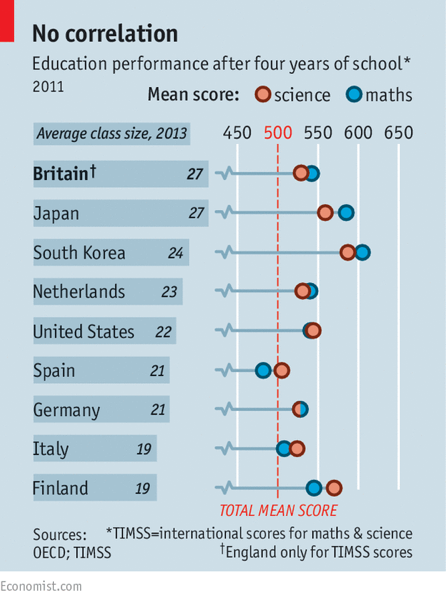 While it may seem counterintuitive, it’s not. It’s well known that Asian classes are twice the size of US classes, and they outperform American students at every level.
While it may seem counterintuitive, it’s not. It’s well known that Asian classes are twice the size of US classes, and they outperform American students at every level.
Of course, progressives don’t like to hear that the smallest class size is a homeschool class. 🙂
Small classes are very costly, yet produce very small benefitsin reading, nothing in math, concludes a newly published study by Danish researchers, reports Hechinger’s Jill Barshay. Reducing class size may hurt students, if schools are forced to hire lower-quality teachers.
U.S. schools have spent heavily to cut class sizes. “Pupil-teacher ratios declined from 22.3 in 1970 to 17.9 in 1985 and dropped to a low of 15.3 in 2008,” writes Barshay. The ratio inched up to16.1 in 2014, “the most recent federal data available.”
Teachers and parents strongly prefer small classes, yet it’s not clear that children learn more.
“[I]n sending my own kids to school, I’d prefer to send them to schools with smaller class sizes,” Robert Slavin, director of Johns Hopkins’ Center for Research and Reform in Education, told Barshay. “But…no studies of high quality have ever found substantial positive effects of reducing class size.”
After analyzing127 studies from 41 countries, researchers selected 10 from the U.S., the Netherlands and France that met stringent quality criteria. They found a very slight chance a small-class student would do better in reading. Students did slightly worse in math, but the result wasn’t statistically significant.
Smaller classes require more teachers. “Would you rather your child were in a small class with an average teacher versus a larger class with a good teacher?” asks Barshay.
I remember when California reduced K-3 class sizes in the mid-90s, requiring schools to scramble for teachers. Suburban schools were able to find qualified teachers. Urban schools took whoever they could get. The neediest students lost ground.
Andreas Schleicher, director of the education and skills unit at the Organization for Economic Cooperation and Development, believes small classes may not be “the best investment of an additional dollar,” notes Barshay. “You can spend a dollar only once and you need to decide whether you invest it into smaller classes, better salaries, more non-teaching working time, or longer student learning hours,” he e-mailed her. “If you make that calculation, almost any of the other factors yield better outcomes.”
https://www.joannejacobs.com/2018/11/small-classes-small-benefits/